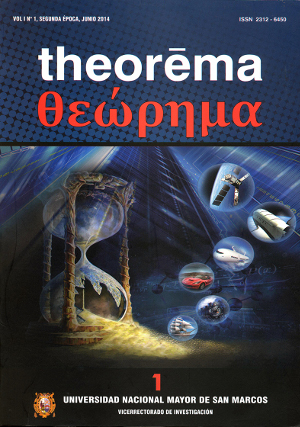Development and testing serologic provirus amplification for molecular study in patients with tuberculosis and the uncertain serology HTLV
Keywords:
Human T-lymphotropic virus type 1(HTLV-1), Human T-lymphotropic virus type 2(HTLV- 2), Nested-PCR Endonucleasas, TB Coinfección.Abstract
In Peru there is geographical regions endemic for human T-cell lymphotropic virus (HTLV) belongs to the family Retroviridae subfamily gender Orthoretrovirinae Deltaretrovirus. Research on virus co infection associated with patients with tuberculosis (TB) and indeterminate serology is limited. This paper conducted the study of 14 cases with indeterminate HTLV serologic profile of a total of 151 patients diagnosed with tuberculosis and outpatient treatment. Preliminary screening tests ELISA and Western blotting were performed to develop molecular protocols Nested-PCR amplification for HTLV, from peripheral blood mononuclear cells. To detect the presence of the two types of HTLV endonucleases were used as restriction enzymes that hydrolyze the DNA at specific sequences of the provirus genome segments. 2/14 (14.2%) positive cases were confirmed HTLV considering protocol for detecting effective lymphotropic virus in co-infected with tuberculosis prototype favored technique and detection of HTLV-1 and HTLV-2 in this coinfected population.The study clearly demonstrated the protocol proviral amplification presence of HTLV was determined in co-infected with tuberculosis and complementary tests of restriction endonucleases, by differences in their electrophoretic migration presence HTLV_I and HTLV-II circulating in outpatient evidenced in TB treatment, becoming a risk of spreading the virus sources. Establishing laboratory methods optimized prevents virus spread in Peru for being endemic to both pathogens. We highlight hence the great importance of clinical follow-up studies of these patients seroconversion missing. The results allow us to suggest implementing this technique in molecular diagnostic health centers, essentially when the profiles of serological diagnoses are uncertain, do not use the technique as a screening test. The establishment of the art laboratories will contribute significantly to the definition of the status of retroviral infection of these individuals for appropriate clinical consejamiento patient. Continue to standardize studies and molecular characterization for existence of viral subtypes.Downloads
Published
Issue
Section
License
Copyright (c) 2016 Egma Mayta Huatuco, Edison Luiz Durigon, Argely Seguil Flores, Nelly Borja Santa Cruz, Tatiane Assone dos Santos, Karen Gaester, Jorge Casseb

This work is licensed under a Creative Commons Attribution-NonCommercial-ShareAlike 4.0 International License.

Theorema segunda época by Vicerrectorado de Investigación y Posgrado is licensed under a Creative Commons Reconocimiento-NoComercial-CompartirIgual 4.0 Internacional License.
Creado a partir de la obra en http://revistasinvestigacion.unmsm.edu.pe/index.php/Theo/index.
AUTHORS RETAIN THEIR RIGHTS:
a. Authors retain their trade mark rights and patent, and also on any process or procedure described in the article.
b. Authors retain their right to share, copy, distribute, perform and publicly communicate their article (eg, to place their article in an institutional repository or publish it in a book), with an acknowledgment of its initial publication in the Theorema segunda época.
c. Authors retain theirs right to make a subsequent publication of their work, to use the article or any part thereof (eg a compilation of his papers, lecture notes, thesis, or a book), always indicating the source of publication (the originator of the work, journal, volume, number and date).



